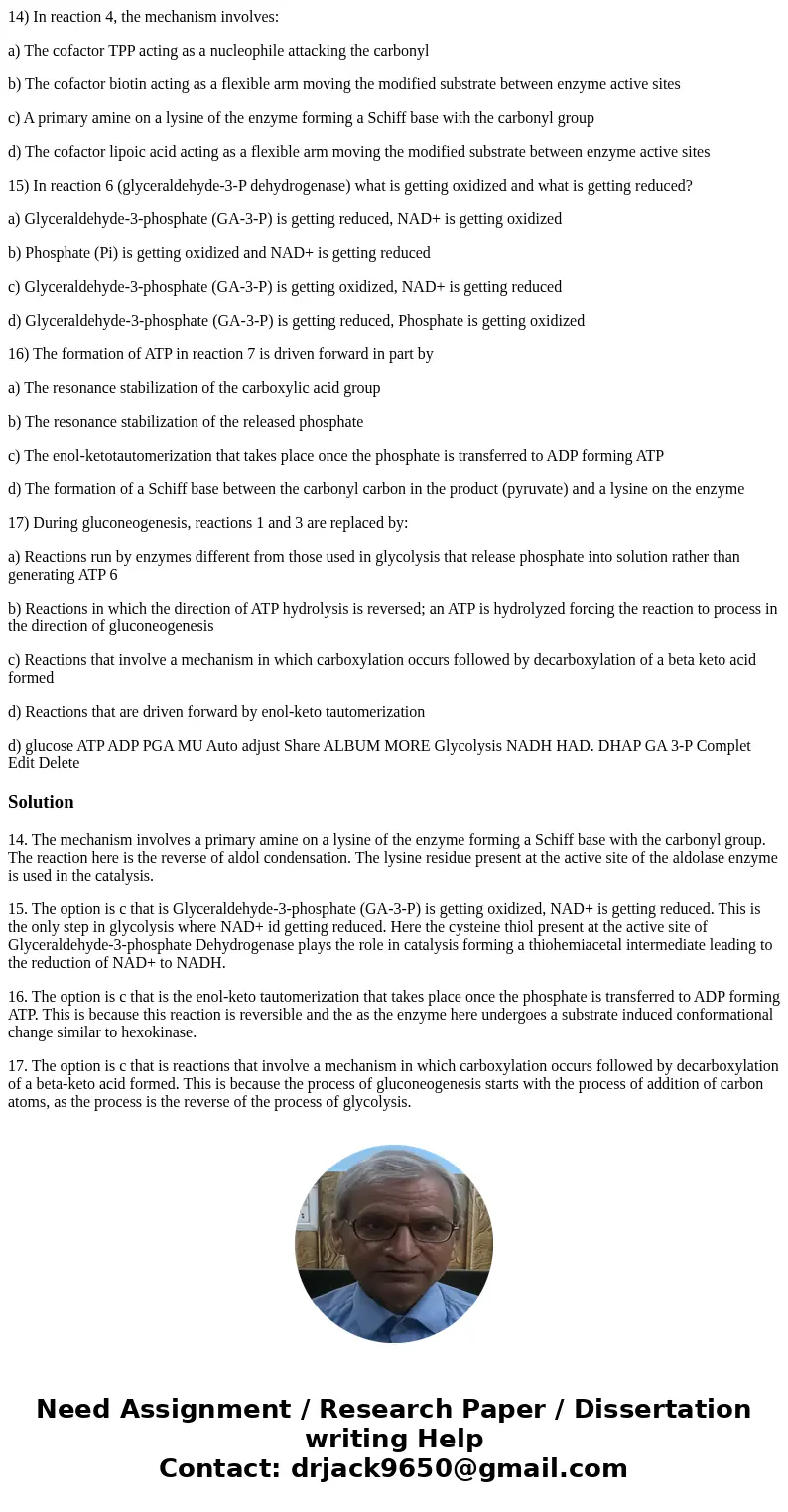14 In reaction 4 the mechanism involves a The cofactor TPP a
14) In reaction 4, the mechanism involves:
a) The cofactor TPP acting as a nucleophile attacking the carbonyl
b) The cofactor biotin acting as a flexible arm moving the modified substrate between enzyme active sites
c) A primary amine on a lysine of the enzyme forming a Schiff base with the carbonyl group
d) The cofactor lipoic acid acting as a flexible arm moving the modified substrate between enzyme active sites
15) In reaction 6 (glyceraldehyde-3-P dehydrogenase) what is getting oxidized and what is getting reduced?
a) Glyceraldehyde-3-phosphate (GA-3-P) is getting reduced, NAD+ is getting oxidized
b) Phosphate (Pi) is getting oxidized and NAD+ is getting reduced
c) Glyceraldehyde-3-phosphate (GA-3-P) is getting oxidized, NAD+ is getting reduced
d) Glyceraldehyde-3-phosphate (GA-3-P) is getting reduced, Phosphate is getting oxidized
16) The formation of ATP in reaction 7 is driven forward in part by
a) The resonance stabilization of the carboxylic acid group
b) The resonance stabilization of the released phosphate
c) The enol-ketotautomerization that takes place once the phosphate is transferred to ADP forming ATP
d) The formation of a Schiff base between the carbonyl carbon in the product (pyruvate) and a lysine on the enzyme
17) During gluconeogenesis, reactions 1 and 3 are replaced by:
a) Reactions run by enzymes different from those used in glycolysis that release phosphate into solution rather than generating ATP 6
b) Reactions in which the direction of ATP hydrolysis is reversed; an ATP is hydrolyzed forcing the reaction to process in the direction of gluconeogenesis
c) Reactions that involve a mechanism in which carboxylation occurs followed by decarboxylation of a beta keto acid formed
d) Reactions that are driven forward by enol-keto tautomerization
d) glucose ATP ADP PGA MU Auto adjust Share ALBUM MORE Glycolysis NADH HAD. DHAP GA 3-P Complet Edit DeleteSolution
14. The mechanism involves a primary amine on a lysine of the enzyme forming a Schiff base with the carbonyl group. The reaction here is the reverse of aldol condensation. The lysine residue present at the active site of the aldolase enzyme is used in the catalysis.
15. The option is c that is Glyceraldehyde-3-phosphate (GA-3-P) is getting oxidized, NAD+ is getting reduced. This is the only step in glycolysis where NAD+ id getting reduced. Here the cysteine thiol present at the active site of Glyceraldehyde-3-phosphate Dehydrogenase plays the role in catalysis forming a thiohemiacetal intermediate leading to the reduction of NAD+ to NADH.
16. The option is c that is the enol-keto tautomerization that takes place once the phosphate is transferred to ADP forming ATP. This is because this reaction is reversible and the as the enzyme here undergoes a substrate induced conformational change similar to hexokinase.
17. The option is c that is reactions that involve a mechanism in which carboxylation occurs followed by decarboxylation of a beta-keto acid formed. This is because the process of gluconeogenesis starts with the process of addition of carbon atoms, as the process is the reverse of the process of glycolysis.

 Homework Sourse
Homework Sourse